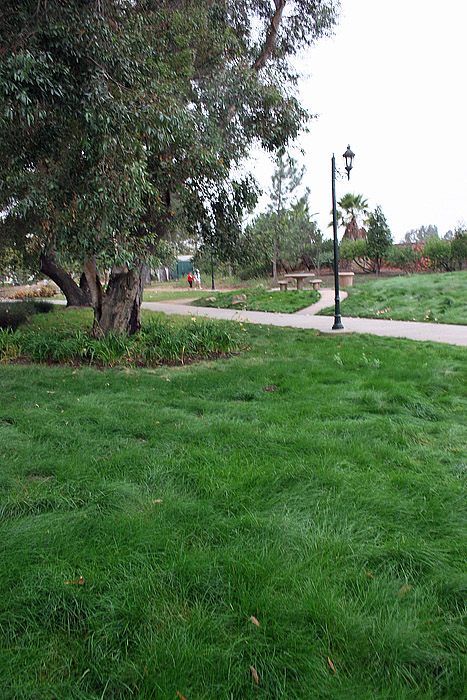Late Summer Lawn Care
As summer winds down and kids head back to school, few people are thinking about lawn care. But with cooler weather encouraging root growth, now is the perfect time to give your lawn some attention. Although it is often overlooked, turf grass is a perennial just like daylilies, hostas, and daffodils. And as with any perennial, care given this year yields a lush, vigorous lawn next year.
Aeration & Cultivation | Fertilization | Grub Control | Overseeding
Aeration
After a hard summer of growing, mowing, foot traffic, and pet stops, lawns want to be rejuvenated. Start with aeration. It is one of the best procedures for a healthy lawn. Aerators and cultivators reduce compaction and allow oxygen to get to the roots. They also break up any thatch which promotes the release of nutrients.
People with large yards can rent mechanical aerators. If possible, pool together with neighbors to share the cost and have a neighborhood aerating day. Those with lawn service should ask for aeration every fall. For those with smaller yards and/or without lawn service (and/or the do-it-yourselfers) there is a neat long handled cultivator called the Grass Stitcher. It comes with an adjustable handle and removable heads in two sizes to quickly aerate even medium sized lawns.
Proper Fertilization
Fall fertilization also rejuvenates the lawn and restores nutrients to the soil. The key to any healthy plant is a well-balanced soil. A soil test helps home-owners figure out which nutrients are lacking. When adding fertilizer, don't overdo it! Overfertilization is a main contributor to the pollution of creeks, rivers, lakes, estuaries, and bays. Only apply what the lawn needs. Follow directions closely to limit the negative environmental impacts.
For those looking for greener fertilizers try Turf Revolution products. Their soil test kit is a great investment for any home owner. Mail the samples to them and they will analyze your soil then return a print-out that explains your nutrient levels in consumer friendly language. In addition, Turf Revolution gives you recommendations on how to improve the health of your soil and therefore your lawn. Their topdressing and fertilizer products are the some of the greenest you can buy. Only plants and minerals are used in their products. Ringer also makes a natural topdressing that is OMRI certified and approved for organic gardening. Topdressings are great for any lawn because they add organic matter and supply nutrients.
Grub Control
Early fall is also a good time to attack grubs in your turf. Their eggs hatch in late summer and the grubs begin to feed on your turf's upper roots. They don't migrate deeper into the soil until cold weather. So now is a chance to control them while they are close to the surface.
Grubs do the bulk of their damage in the fall, with a little more feeding in the spring before they pupate and turn into adults. Controlling them now is a double duty solution. You can stop them from damaging your lawn this fall. And next year, since you killed them as grubs, they won't have a chance to mature into Japanese beetles, June bugs, cinch bugs, and other baddies, which attack your roses, grapes, and other plants.
Controlling grubs does not require harsh chemicals. Safer makes an easy to use Grub Killer spray that attaches to a water hose. Their Grub Killer is made from a derivative of the neem tree and approved for organic gardening and OMRI certified. The packet also attaches to a spray hose for easy application. Another green (and cool) way to control grubs is Organic Control's Beneficial Nematodes. Beneficial nematodes are microscopic worms that feed on grubs in the soil. It's like using good nature vs. the bad guys.
Seeding
Once you have aerated, fertilized, and treated for grubs (only if you have them) complete your late summer lawn care by overseeding. Most weed seeds are programmed to germinate in the spring. Grass seed sown now has less competition for water, nutrients, and light. Also sowing now gives them time to grow strong healthy roots before frost. In the spring the turf will be better established and able to choke out weed seedlings. You'll notice fewer weeds in your lawn, especially annual weeds such as crabgrass.
Like with any plant, start with good seed. Don't skimp on seed. Buy a good blend (various cultivars) and/or mixture (various species). For homeowners wanting a low maintenance lawn try Eco-Lawn seed. This is blend of native fescue grasses that are drought tolerant, shade tolerant, and adaptable throughout the US. It grows more slowly than Kentucky bluegrass or other common grass types so it needs much less mowing (3-5 times a year) and little to no fertilizer. Because it requires fewer inputs (less water, less fertilizer, less mowing, less gas, less time, less money) an Eco-Lawn is one the greenest turfs of all times. [Being green means conserving resources, especially money!]
For those wanting a more traditional lawn and willing to do maintenance Seed Super Store offers a blend formulated for your specific zip code. They supply the newest cultivars with the best genetics, typically only available to turf professionals. As a bonus the website is filled with useful info on turfcare.
|

Shady Eco-Lawn |
A little effort now goes a long way. While others are battling weed seeds and trying to establish turf seed during a cold, wet spring, you'll be sitting pretty watching the grass grow. Like with daffodils and tulips, the work done now makes next year more enjoyable.